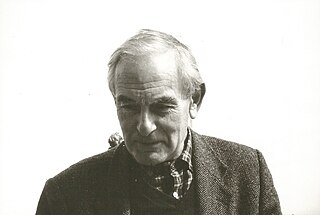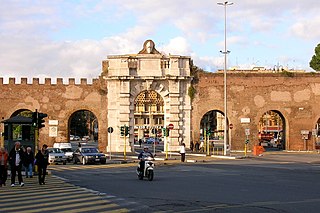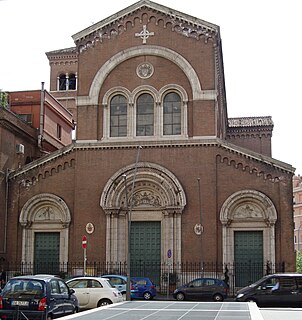Name
The new street was entitled "Via dei Cessati Spiriti" by Resolution of the Municipal Council nr. 14 of February 2, 1945, which reads:
«The stretch of Via Appia Nuova which, following the adjustment of the route of the same, has come to form a road in its own right which, departing from Via Appia Nuova itself, almost in front of the Velodrome, and precisely at the street number 618, reaches again Via Appia Nuova at Arco di Travertino.»
The odonimy of Rome describes the name as follows: "From the evildoers and people of ill repute who infested the area".
History
The area of the Caffarella valley, close to the junction between the Via Latina and the former route of the Via Appia Nuova, had been called delli Spiriti (Italian for "of the Spirits") since the 16th century, due to unpleasant nighttime meetings [2] .
It is said, in fact, that many wanderers stopped with their carriage and horse to eat and rest in an old tavern that was there; when they left the tavern, both carriage and horse had disappeared.
Since nobody could ever see who carried out these thefts, and because of the noises that were heard at night, the responsibility was attributed to the spirits that haunted the valley.
The legend survived until 19th century when, to chase away such 'spirits', a statuette of the Madonna was placed on the front of a building [3] .
The end of the thefts of carriages and horses generated the rumor that the spirits had 'ceased', so that a tavern of the place took the name of Osteria dei Cessati Spiriti ("Tavern of the Ceased Spirits").
On July 2, 1910, Adriano Bennicelli – a Roman nobleman who lived between 1860 and 1925 and was nicknamed il Conte Tacchia – called an electoral rally at the Osteria dei Cessati Spiriti, by putting up a large number of posters, after having decided to run for the elections for the Chamber of Deputies in the lists of the Liberal Party. However, the rally had little response and the low number of votes did not allow him to be elected. [4]
Fonderie Bruni
In 1890 – as attested by the marble plaque above the abreuvoir – the Bruni company moved to the street from its former headquarters in Via Tiburtina: the firm operated in the casting of statues until its shutdown in 1965.
The abandoned and damaged building, in need of maintenance and with no intended use, appeared as a ruin of industrial archeology in danger of collapse until the end of 2018; during 2019, the two buildings of the complex saw the start of the restoration and renovation works, aimed at the construction of lofts and apartments.

Federico Fellini, was an Italian film director and screenwriter known for his distinctive style, which blends fantasy and baroque images with earthiness. He is recognized as one of the greatest and most influential filmmakers of all time. His films have ranked highly in critical polls such as that of Cahiers du Cinéma and Sight & Sound, which lists his 1963 film 8+1⁄2 as the 10th-greatest film.

The Appian Way is one of the earliest and strategically most important Roman roads of the ancient republic. It connected Rome to Brindisi, in southeast Italy. Its importance is indicated by its common name, recorded by Statius, of Appia longarum... regina viarum.

La dolce vita is a 1960 comedy-drama film directed and co-written by Federico Fellini. The film follows Marcello Rubini, a journalist writing for gossip magazines, over seven days and nights on his journey through the "sweet life" of Rome in a fruitless search for love and happiness. The screenplay, co-written by Fellini and three other screenwriters, can be divided into a prologue, seven major episodes interrupted by an intermezzo, and an epilogue, according to the most common interpretation.

Terracina is an Italian city and comune of the province of Latina, located on the coast 56 km (35 mi) southeast of Rome on the Via Appia. The site has been continuously occupied since antiquity.

Mario Brega was an Italian character actor. His heavy build meant that he regularly portrayed a thug in his films, particularly earlier in his career in westerns. Later in his career, however, he featured in numerous Italian comedy films. Brega stood at 6 feet 4 inches (1.93 m) and well over 250 pounds (110 kg) at his heaviest but after the 1960s slimmed down significantly.

Lucos Cozza was a Roman archaeologist.
Gianni Di Venanzo, was an Italian cinematographer.

The Via dei Fori Imperiali is a road in the centre of the city of Rome, Italy, that runs in a straight line from the Piazza Venezia to the Colosseum. Its course takes it over parts of the Forum of Trajan, Forum of Augustus and Forum of Nerva, parts of which can be seen on both sides of the road. Since the 1990s, there has been a great deal of archeological excavation on both sides of the road, as significant Imperial Roman relics remain to be found underneath it.

Antonio del Massaro da Viterbo, or Antonio da Viterbo, nicknamed il Pastura was an Italian painter.
Valentina Moncada di Paternò is an Italian art historian, gallery owner, and curator who specializes in contemporary art. In 1990 she opened an art gallery in Rome in Via Margutta 54, establishing herself as a talent scout due to a program of young international artists who soon became known worldwide.

The Appian Way Regional Park is the second-largest urban park of Europe, after Losiny Ostrov National Park in Moscow. It is a protected area of around 4580 hectares, established by the Italian region of Latium. It falls primarily within the territory of Rome but parts also extend into the neighbouring towns of Ciampino and Marino.
Maurizio Trifone is an Italian linguist and lexicographer.

Mimmo Poli was an Italian film character actor.
Annibale Ruccello was an Italian playwright, theatre director, and actor.

The Almone is a small river of the Ager Romanus, a few miles south of the city of Rome. Today the river is polluted and is channelled to a sewage treatment plant and no longer reaches its natural confluence with the Tiber.

Cademia Siciliana is a transnational non-profit organization founded in 2016 by a group of Sicilian language academics, activists, researchers, and students with the mission to promote the Sicilian language through education, research, and activism. The organization has published an orthographical proposal for the Sicilian language, and maintains several Sicilian language research and technology projects. Including translation and language advocacy projects for several popular applications and platforms such as Firefox, Telegram, Facebook and Android Keyboard.In 2021 the group gained attention for their collaboration with Google's Woolaroo, an augmented reality project intended to support regional and minority languages.

Municipio Roma VII is the seventh administrative subdivision of the Municipality of Rome (Italy).
Corso di Francia, informally called Corso Francia, is a street in the northern area of Rome (Italy).
It runs in a south–north direction between the Quarters Parioli and Tor di Quinto and, together with the nearby Via del Foro Italico and Viale Guglielmo Marconi, is the only urban road in the town to overpass the Tiber keeping the same name on both banks.

Appio-Latino is the 9th quartiere of Rome (Italy), identified by the initials Q. IX. The name derives from the ancient roads Via Appia and Via Latina. It belongs to the Municipio VII and Municipio VIII.

The Church of Ognissanti is a Catholic place of worship in Rome (Italy), located in the Quarter Q. IX Appio-Latino, along Via Appia Nuova, near Piazza Re di Roma; it is the seat of the homonymous parish entrusted to the Sons of Divine Providence.















